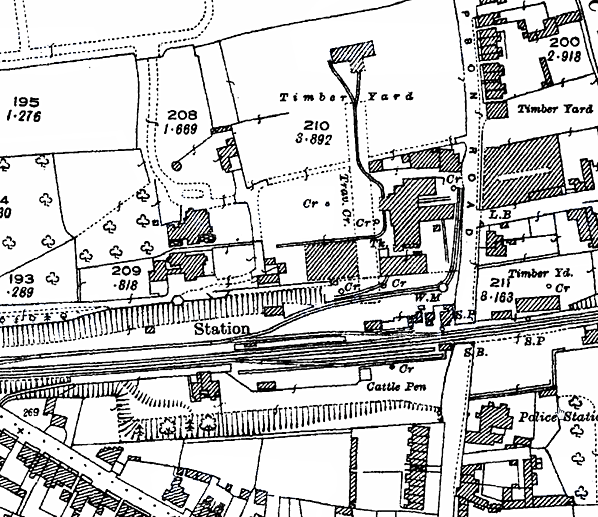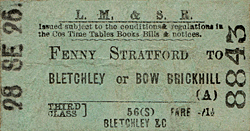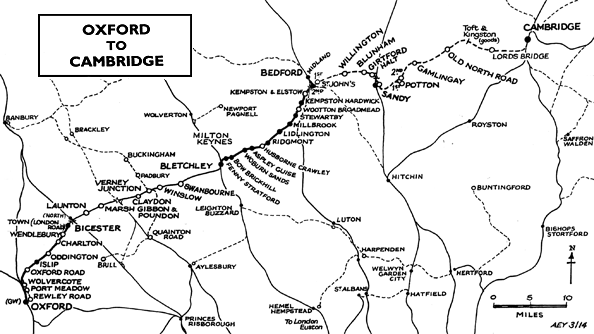
[Source: Nick Catford]
stratford_old2.jpg) Looking east from Watling Street towards Fenny Stratford station in 1904. At that time the station had staggered platforms. The up platform is on the right with the down platform north of the Simpson Road level crossing which can be seen to the left of the signal box in the distance. There was an inclined access path to the up platform (seen on the right) from Watling Street. This is still in use today. Goods sidings are seen on both sides of the line.
Copyright photo from John Alsop collection   1881 1:2,500 OS maps shows Fenny Stratford station as built with two staggered platforms. There are sidings on both sides of the line, that on the down side looping round the platform. The two sides of the yard were joined by a short length of track running at right angles across the main line and reached by turnplates. There was no signal box at this time. Although Rowland Brothers’ saw mill opened in 1874 it is not shown on this map.
 1900 1:2,500 OS map. The line linking the two side of the goods yard has now been removed. The cattle dock and pens and a one-ton crane are identified in the up goods yard. A signal box is now shown on the up side to the east of the crossing. The weighbridge (WM) is seen at the entrance to the down yard, although not identified the coal yard was sited on this side. Rowland Brothers saw mill is now shown with a long siding running from the loop and a turnplate where the siding turns sharply north to run alongside Simpson Road. A short length of narrow gauge tramway links two buildings in the saw mills and a travelling gantry crane runs north across the site from the siding.
 1925 1:2,500 OS map. Rowland Brothers’ saw mills have expanded with more buildings and a network of narrow gauge lines. One runs parallel to the standard gauge siding. The travelling gantry crane runs over both lines for the transhipment of timber onto wagons in the siding. Click here for a large
version of this map. stratford_old4.jpg) Looking east from Watling Street towards Fenny Stratford station c1910. An eastbound passenger train is seen in the down platform with a mixture of goods wagons in the down siding. Strangely the Rowland Brothers’ siding on the down side is not visible although the end of the travelling gantry crane that goes over the top of it is seen (click here for a larger version of this picture). Sidings are also seen on the up side beyond the platform as is the one-ton capacity yard crane.
Copyright photo from John Alsop collection stratford_old3.jpg) A similar view of Fenny Stratford station also c 1910. A westbound passenger train is seen departing. Again the Rowland Brothers’ siding to the left of the wagons is not visible although it had certainly been laid by this time.
Copyright photo from John Alsop collection stratford_old6.jpg) A local passenger train is passing the down platform and approaching the up platform at Fenny Stratford station in 1938. 8637 is a Webb designed Cauliflower Class loco built for the LNWR in 1892. Built at Crewe works and originally numbered 1267, it passed to the LMS at the Big Four Grouping in 1924 and was renumbered to 8637 and again in 1944 to 28367. It never quite made it into the BR era being withdrawn after over 55 years service during November 1947 and scrapped shortly after. The up side sidings are seen on the right. Wagons can be seen on the down siding behind the station nameboard.
Photo from John Mann collection stratford_old5.jpg) Looking east along the up platform in April 1950. The platforms were rebuilt two years earlier. The original down platform was demolished and a replacement built opposite the up platform. The platform is of timber construction with a waiting shelter made of concrete blocks with a sloping corrugated sheet roof. As before the down side goods yard and the siding to Rowland Brothers’ saw mill is behind the platform. In 1942 the mill was sold to the London-based timber company James Latham. Although no longer rail-served the company stayed at Fenny Stratford and still has its head office there.
Copyright photo from John Alsop collection stratford2.jpg) Fenny Stratford station looking east in January 1958. The down platform (left) is built of timber and replaced the original down platform (which was closer to the level crossing) in 1948.
Copyright photo by RM Casserley stratford1.jpg) Fenny Stratford station looking east from the up platform in January 1958. The goods yard is seen at the end of the platform. The loop running behind the down platform is seen on the right. The original down platform ran from the east end of the new platform to the level crossing.
Copyright photo by RM Casserley stratford_old7.jpg) A class J freight (through minerals or empty wagons) is being hauled through Fenny Stratford station in January 1958 by LMS-built 4F 44447, a Fowler-designed 0-6-0 built at Crewe works in 1928. Withdrawn from Barrow-in-Furness shed in July of 1963 after 35 years service, it was broken up during December of that year. The travelling gantry crane in Rowland Brothers’ saw mill is seen on the left.
Photo from John Mann collection stratford_old8.jpg) The view from the Watling Street bridge at Fenny Stratford has always attracted railway photographers. This view looking east in April 1966 shows 4-car Derby Lightweight DMU on an Oxford service in April 1966.It is just possible to make out the rails of the Rowland Brothers’ siding curving to the left behind the down platform.
Photo from John Mann collection stratford_old9.jpg) Fenny Stratford station looking west c late 1960s. The Watling Street bridge is seen at the end of the platform. When the railway was built Watling Street was raised by some 6ft 8in to allow the railway to pass beneath,
Photo from John Mann collection
stratford_old10.jpg) Fenny Stratford was one of four stations on the Bedford to Bletchley line to have a building in a cottage orné Gothic Revival style at the insistence of the 7th Duke of Bedford. The entrance to the booking office is under the arched verandah on the far side of the building with the exit onto the platform under the verandah on the near side (c 1970).
Photo from John Mann collection stratford_old15.jpg) Fenny Stratford station looking east c 1970.
Photo from John Mann collection stratford_old22.jpg) Fenny Stratford station looking east along the down platform in August 1970. By this date all the sidings has been lifted. There were sidings behind the down platform (left) and between the up platform and the signal box. Photo by John Mann stratford_old16.jpg) A 2-car Cravens Class 105 DMU waits at Fenny Stratford station in December 1972 shortly after the line thorough the station had been singled and the down track had been lifted. At this time the Bletchley - Bedford service was under threat of withdrawal, and the closure date of 31
December had been announced. Photo by John Evans from his Flickr photostream Click here for Fenny Stratford Station Gallery 2
|

 Freight facilities at Fenny Stratford were limited because of the proximity of the large goods yard at Bletchley. There was a small yard on the up side immediately west of the level crossing. There were two sidings serving a cattle dock and pens. There was also a small one-ton capacity crane. On the down side there was a loop siding running round the back of the down platform; this served the coal yard. The two sides of the goods yard were joined by a line running at right angles across the main line reached by turnplates. This allowed individual wagons to be moved across the main line. This line and the turnplates had been removed by 1900.
Freight facilities at Fenny Stratford were limited because of the proximity of the large goods yard at Bletchley. There was a small yard on the up side immediately west of the level crossing. There were two sidings serving a cattle dock and pens. There was also a small one-ton capacity crane. On the down side there was a loop siding running round the back of the down platform; this served the coal yard. The two sides of the goods yard were joined by a line running at right angles across the main line reached by turnplates. This allowed individual wagons to be moved across the main line. This line and the turnplates had been removed by 1900.  All that now remains is one platform and an area of wasteland east of the station before Simpson Road crossing which was controlled by a signal box that was taken out of service in 2004. There was an
All that now remains is one platform and an area of wasteland east of the station before Simpson Road crossing which was controlled by a signal box that was taken out of service in 2004. There was an 
 In 1955 the Railway Modernisation Plan proposed improvements to cross-country facilities between Oxford and Cambridge with the aim of maintaining a link between the major main line railways outside the congested Greater London area thereby allowing freight traffic to be transferred between three railway regions and easing the burden on London marshalling yards. Within a few years the policy changed and the line was not upgraded with the Bletchley flyover remaining as a monument to the fruitless proposal.
In 1955 the Railway Modernisation Plan proposed improvements to cross-country facilities between Oxford and Cambridge with the aim of maintaining a link between the major main line railways outside the congested Greater London area thereby allowing freight traffic to be transferred between three railway regions and easing the burden on London marshalling yards. Within a few years the policy changed and the line was not upgraded with the Bletchley flyover remaining as a monument to the fruitless proposal.
 For much of the twentieth century this 16-mile line had a particularly distinctive character, its closely-spaced stations being either in the Gothic Revival style or diminutive halts. The numerous staffed level crossings also gave the line a certain charm; even in the mid 1980s the passenger would be aware of gate-keepers standing at each crossing as their train passed. The landscape was also distinctive between Bedford and Ridgmont as the route was hemmed in by forests of tall chimneys and massive clay pits. Nowhere was this more the case than at Stewartby. From 1968 until its replacement in 1984 on a new route into Bedford (Midland) the Bedford – Bletchley line had its eastern terminus at Bedford St Johns, an unstaffed ‘halt’ an inconvenient distance from the main line station.
For much of the twentieth century this 16-mile line had a particularly distinctive character, its closely-spaced stations being either in the Gothic Revival style or diminutive halts. The numerous staffed level crossings also gave the line a certain charm; even in the mid 1980s the passenger would be aware of gate-keepers standing at each crossing as their train passed. The landscape was also distinctive between Bedford and Ridgmont as the route was hemmed in by forests of tall chimneys and massive clay pits. Nowhere was this more the case than at Stewartby. From 1968 until its replacement in 1984 on a new route into Bedford (Midland) the Bedford – Bletchley line had its eastern terminus at Bedford St Johns, an unstaffed ‘halt’ an inconvenient distance from the main line station.
 Home Page
Home Page